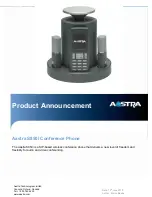
MERLIN LEGEND Communications System Release 6.0
System Manager’s Guide
555-660-118
Issue 1
February 1998
About Telecommunications
Page B-10
Signaling
B
alternating current (AC), a different kind of frequency is used. In 1976, AT&T
introduced a new interoffice signaling scheme called common channel interoffice
signaling (CCIS) in which a separate circuit between the offices is dedicated to
digital signaling transmissions between the computers that control the switches.
The enhanced CCIS system in use today is called
common channeling signaling
(CCS) system and supports advanced features, such as calling-number
identification (Caller ID). The calling party’s number is transmitted from switching
office to office. This and other advanced services are available on the “intelligent”
network that has evolved because of the use of computers to control signaling.
Telephone Numbering Plans
2
Unlike the verbal communication of the called party’s name in manually switched
systems, automated switching systems require that each telephone extension be
identified by a unique address that is convenient, readily understandable, and
similar in format to other extensions connected to the network.
In the early days of telecommunications, when a maximum of 10,000 lines could
be serviced by a telephone exchange, a 4-digit alphanumeric “address” was used
to specify the called party, for example, WA51 (Waverly 51).
Subsequently, 3-digit area codes were introduced to specify the area of the
country to be reached, and country codes were introduced for international
dialing. Finally, the individual telephone numbers expanded to the 7-digit numbers
in use today: a 3-digit central office code and a 4-digit extension number.
NOTE:
In the past, the North American Numbering Plan has used area codes that
have only a 0 or 1 for the middle digit, for example, 908 or 215. Currently,
the numbering plan is being changed so that any number (0 through 9) can
be used for the middle digit. This system has already been designed to
take that change into account.
Various standardized numbers have also been created for special services, for
example, area code 800 for toll-free service, and 911 for emergency service.
A special numbering plan is also used within the MERLIN LEGEND
Communications System to identify individual telephones, adjuncts (for example,
fax machines), trunks, and other features and aspects of the system. Depending
on the number of extensions and the needs of your company, you can choose
from three different numbering plans that allow 2-digit numbers, 3-digit numbers,
or customizable variable-length numbers, respectively.
















































